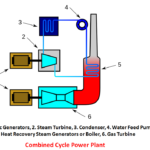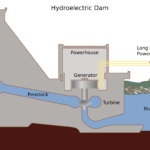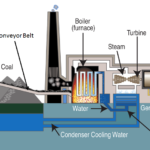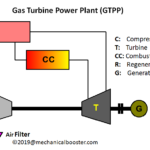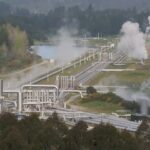Introduction
When we talk about word nuclear, what strikes our mind is an immense amount of energy. Keeping in mind the material handling complexities and safety concerns, it’s still been most abundantly used source of energy for producing power all around the world. Extracting power from nuclear fuel has now become a need, to meet the increasing energy demands and for economical growth of a country. Nuclear power plant generates electrical energy using heat energy and Uranium-235 is used as a fuel, to produce that heat.
Why Nuclear Power Plant is Invented?
The depletion of the non-renewable energy resources forces the scientist of the world to find a new source of energy which can fulfill the requirement of the electricity demand of the world. It was the year 1948 when electricity was generated for the first time at X-10 Graphite reactor in Oak Ridge, Tennessee of United States of America. It was the first nuclear power plant which powers a light bulb.
Working Principle
The energy source of a nuclear power plant is fission reaction. In fission reaction we start with an unstable atom (uranium-235) which splits apart into two small more stable atoms. When we go from something that is really very unstable (uranium-235) to thing that is more stable (barium and krypton), energy is released. Now to split the uranium atom we need to aggravate it, what we do is we strike a neutron into this big uranium atom, which converts it into uranium-236 from uranium -235. Uranium-236 is super unstable atom and splits up into krypton-92 and barium-141, which are way more stable. Other than release of energy, 3 free neutrons are also released in the process. These neutrons further strikes another 3 uranium atoms and starts up a chain reaction, helping in getting a great amount of thermal energy.
What’s Inside a Nuclear Power Plant?
1. Reactor pressure vessel
In reactor pressure vessel the nuclear fission reaction takes place, it contains the fuel rods, moderator and control rods. This arrangement is again covered under a containment building made of reinforced concrete and can sustain load as high as 40 thousand ton. The water in the vessel is heated under a high pressure, making its boiling point as high as 300 degree centigrade.
2. Fuel rods
Fuel is contained in these fuel rods as fuel pellets. These fuel rods contain a number of fuel pellets, and neutrons hit these fuel pellets to start and continue the fission reaction.
3. Moderator
Moderator is the liquid contained in the pressure vessel at high pressure .It is generally heavy water. The main function of moderator is to slow down the highly energized neutrons so that they can again collide with uranium atom. More importantly it’s the appropriate velocity of neutron which is required to split the uranium atom.
If the first neutron which hit the uranium atom has got a energy of 0.04ev then the resulting 3 neutrons will have 1ev of energy, which is needed to be slowed down to 0.04ev again that is where moderator comes into play.
Also Read:
- How Wind Power Plant Works?- Complete Explanation
- How Geothermal Power Plant Works – Explained?
- Solar Power Plant – Main Components, Working, Advantages and Disadvantages
4. Control rods
Control rods are the most important part of a nuclear reactor in nuclear power plant, and are made up of Barium or Cadmium. It controls the ongoing nuclear reaction by absorbing the neutrons and we can also control the energy production as per the requirement, by inserting the control rods accordingly.
5. Heat Exchanger
Water from pressurized vessel is then pumped to the heat exchanger also called as steam generator. The thermal energy of water from pressurized vessel is transferred to the water taken from river or from cooling tower through heat exchanger, and convert it into high pressurized steam, as we cannot use the water in the pressurized vessel to produce steam because it is in direct contact with fuel rods and is radioactive, and cannot leave the plant in any case.
6. Turbine
Steam turbine is made to rotate by the high pressurized steam and the shaft of this turbine is further connected to the generator.
7. Generator
It converts the rotational motion of turbine-generator coupling into electrical energy. This electrical energy is then stepped-up to high voltage through transformer and is then transmitted to the nearest power grid through transmission lines.
8. Condenser
Condenser converts the steam coming from the turbine into water so that it could be pumped to cooling tower to be circulated to the heat exchanger again. We can also have cold water from river and cooling tower simultaneously for the circuit, if we have river flowing nearby the plant.
9. Cooling Tower
It cools down the water pumped from the condenser, using expansion process. Hot water is sprayed from a certain height and it cools down to cool water now ready to be re-circulated to the heat exchanger.
Working of Nuclear Power Plant

It all starts with a thermal neutron striking the uranium pellet and starting the chain reaction, with release of 3 new high energy neutrons as by-products of this exothermic reaction. These neutrons strike another 3 uranium atoms, and this chain reaction keeps on increasing. Heavy water is feed into the high pressure vessel which absorbs the heat generated by the chain reaction. This water doesn’t really boil as its being heated under high pressure. This is not the ordinary water that is feed into high pressure vessel; it’s 10 times heavier than the ordinary water. The main function of this water is to slow down the high energy neutrons to the level of thermal neutron or to modify the speed of neutron, that’s why it is called moderator. When neutrons travels in heavy water (deuterium oxide) it strikes with each and every molecule of heavy water thus transferring its energy to moderator, and slows down to an optimum speed.
In nuclear power plant, the chain reaction so started is controlled by the controls rods mainly boron or cadmium rods. These rods absorb the extra neutrons thus stopping the chain reaction. Generally these rods are put in and out of pressure vessel every 10 seconds, to control the power output according to the requirement or load at the turbine.
Heated water or moderator in the pressurized vessel is then pumped to the heat exchanger. Keeping in mind moderator cannot leave the circuit as it is radioactive so the water for the heat exchange is pumped from a water source (river) and this water absorbs the heat of moderator and converts into highly pressurized steam.
This pressurized steam is first feed in a high pressure turbine which converts its pressure energy into mechanical energy, but this steam still have enough pressure energy left in it to turn a low pressure turbine, so this combined mechanical energy from both the turbines is used to turn the armature of a generator thus producing electricity.
This electricity is then stepped-up to high voltage by step-up transformer, and transmitted to the nearest power grid through transmission lines.
The steam that leaves the turbines is then condensed in a condenser. The condenser is connected to the cooling tower. The cold water from the cooling tower takes the heat from the condensed water of the condenser. The hot water in cooling tower is sprayed in air thus cooling it down, to be again pumped back to the condenser.
For better understanding about how nuclear power plant works watch the video:
Where Used Nuclear Fuel Goes?
The nuclear fuel once used in nuclear power plant is removed from the reactor and stored in a pool of water for about 7-10 years. The purpose of the water pool is to cool down the nuclear fuel and provide shielding from radiation.
All the pools that are used for storage of radioactive material are constructed in a separate building and are made so strong that they can even survive earthquakes.
Also Read:
- Advantages and Disadvantages of Tidal Energy
- Steam Power Plant Construction,Working, Advantages and Disadvantages with Diagram
- How Coal Power Plant Works? – Do You Know?
Safety
- There are many sensors that are installed in a reactor of nuclear power plant like temperature, pressure and power level sensors. Reactor will automatically shut down, if these sensors reach to some critical value.
- If there is any pressure leakage in the reactor building, then it is controlled by spraying water, thus reducing the pressure caused by steam in the reactor.
- Or in multi-reactor building there is a separate vacuum tank, the pressure is released to this tank in case of a leakage; it has also got a water spraying system, to further lower the pressure.
- There is always a power backup for the equipments of cooling system, to avoid any accident in case to total blackout. Blackout was the reason behind the Fukushima accident in Japan, due to tsunami.
Advantages of Nuclear Energy
- There is no pollution in generating electricity from nuclear reaction in nuclear power plant.
- The operating cost of reactor is quite low, and the life of a reactor is about 50-60 years before it goes out of business
- Reliability and consistency over a long period of time is the prime factor which makes it an extraordinary source of power, as it does not depend upon weather conditions.
- Uranium is available in a large amount and going to last longer than fossil fuels.
- If any country sets up a nuclear power plant, then it does not have to worry about the fluctuating prices of fossil fuels and worlds environmental rules and regulations.
Disadvantages of Nuclear Energy
- The biggest challenge of nuclear power plant is to store the used fuel, as it would cover up a piece of land for a large number of years.
- You have to keep an eye on the waste storage plant, for it to be safe and check for radiation to be under limit.
- There is always a chance of nuclear accident as in Fukushima, Japan due to tsunami. The bad effects of radiation remain for a long time, over generations.
- This energy has got so much of power in it, that if it goes into wrong hands it could destroy human race from earth.
Well said,
First man splitted the atom, now atom splits man.


